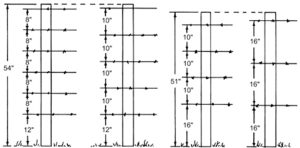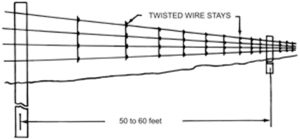During the winter months as forage supplies get shorter and shorter, cattle tend to want to wander to the greener grass on the other side of the fence. It is important that fences are sound whether ranchers want to keep their cattle contained or maybe keep other’s livestock out of their greener pastures. Choosing the right fence for the job, whether perimeter or interior, is very important.
There are several types of fences commonly used on ranches including board, barbed wire, woven wire, cable, mesh, high-tensile, electric or a combination of any of these. The type of fence one might choose depends on the livestock, crops, or vegetation that borders the fence and the budget. Because fencing usually represents a rather large investment, it is important to choose a fence that is affordable, easy to maintain, durable and, most importantly, contains livestock. For the purposes of this article, we are going to discuss the types of fences most used on Florida beef cattle operations. These include barbed wire, woven wire, high-tensile and electric fences.
Barbed Wire Fences
Barbed wire fences are likely the most popular fence types of cattle ranchers in our region. Barbed wire is comprised of two or more strands of smooth, galvanized steel wire twisted together with two or four barbs spaced every 4 to 5 inches. Barbed wire fences are generally classified into two categories: standard barbed wire fences and suspension barbed wire fences.
Standard barbed wire fences (Figure 1) usually have posts spaced 10 to 12 feet apart and use three to five strands of wire. Suspension barbed wire fences (Figure 2) consist of four to six strands of barbed wire. Each strand is stretched taut so there is no more than three inches sag between posts. The suspended barbed wires are held apart by twisted wire stays or short pieces of fiberglass posts spaced approximately 10 to 12 feet apart. Line posts are spaced from 50 to 60 feet apart. The suspension barbed wire fence sways back and forth in the wind or when animals hit it. The swaying motion helps keep animals away from the fence and discourages them from fighting through it. For this reason the lower end of the stays must not touch the ground or the effectiveness of the suspension fence will be reduced.
Figure 1. Common spacings of wire strands in barbed wire fences.

Figure 2. Typical barbed wire suspension fence.

The advantages of barbed wire fences are that they can be economical and adaptive to install. If the initial budget is an issue, one can limit the number of strands initially used to three strands and then add more strands later. This allows for some flexibility in the budget. Barbed wire can be easy to install and can be repaired with ease if it fails by splicing it back together.
On the downside, barbwire can injure an agitated animal if they lean or fall on it. Moreover, the wire may not have enough tensile strength to withstand pressure from animals or falling objects. Barbed wire fences do require a moderate amount of maintenance.
Woven Wire Fences
Woven wire fences are also called field fences. This type of fencing is made of high tensile wires of different gauges. They consist of a number of horizontal lines of smooth wire held apart by vertical wires called stays. The spacing between the stays can vary from 2 to 12 inches apart. Spacing between horizontal line wires may vary from as close as 1.5 inches at the bottom for small animals to 10 inches at the top for large animals. Spacing of the wires generally gets wider as the fence gets higher. Many combinations of wire sizes and spacing as well as several fence heights are available. The standard design numbers listed on the tag describe the wire. For instance, a design number 1047-12-11 indicates the wire has 10 horizontal wires and is 47 inches high, stays are spaced 12 inches apart and stay-and-filler wires (wires between the top and bottom line wires) are 11 gauge wire. The top and bottom wires are generally two sizes larger.
If installed correctly, woven wire fences have a long lifespan and are relatively low maintenance. Woven wire can withstand greater pressure from large animals or falling objects before failing. On the other hand, woven wire fences can be an injury risk if the cattle’s hooves get stuck between the wires. The high tensile wires can also be problematic if an animal rams into them with a lot of pressure. Given that these wires do not stretch, they’re likely to split and cause deadly cuts on the animal during such instances. Despite its longevity, the initial investment of woven wire fencing is relatively high.
 0
0
